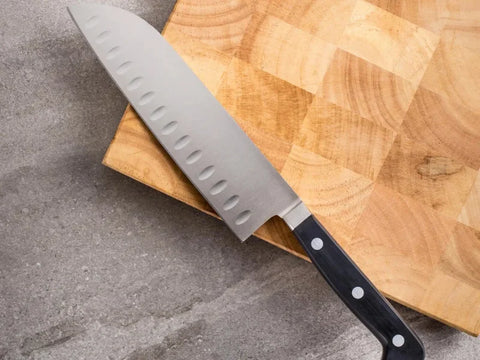TL;DR: A Granton edge Santoku knife features small dimples along the blade that reduce food sticking and improve slicing efficiency. It combines Japanese precision with practical design, making it ideal...
TL;DR: Japanese Hinoki cypress or end-grain hardwood boards protect Nakiri's thin, hard edge best. Avoid glass, stone, or bamboo. Choose boards with knife-friendly softness, antimicrobial properties, and stability for precise...
TL;DR: Nakiri excels at vegetable prep with its flat, rectangular blade and straight cuts. Gyuto serves as an all-purpose knife for meat, fish, and vegetables. Choose Nakiri for dedicated vegetable...
TL;DR: Santoku knives excel at precision slicing, dicing, and mincing with their thin, sharp blades and balanced design. Serbian chef knives handle heavy-duty tasks like chopping bones and tough vegetables...
TL;DR: Santoku knives are versatile 5–7-inch Japanese blades perfect for chopping, slicing, and dicing vegetables, meat, and fish. Slicing knives are longer, thinner blades designed specifically for carving roasts and...
TL;DR: Chai Dao knives offer broader, cleaver-like blades perfect for heavy-duty prep and larger vegetables, while Santoku knives provide precise control with their flat edges for slicing, dicing, and mincing....
<div class="dynamic-checkout__content" id="dynamic-checkout-cart" data-shopify="dynamic-checkout-cart"> <shopify-accelerated-checkout-cart wallet-configs="[{"name":"shop_pay","wallet_params":{"shopId":92870279483,"merchantName":"Kasumi Japan","personalized":true}},{"name":"amazon_pay","wallet_params":{"checkoutLanguage":"en_US","ledgerCurrency":"USD","placement":"Cart","sandbox":false,"merchantId":"A2YAWQIMXDDTD8","productType":"PayAndShip","design":"C0002"}},{"name":"paypal","wallet_params":{"shopId":92870279483,"countryCode":"US","merchantName":"Kasumi Japan","phoneRequired":true,"companyRequired":false,"shippingType":"shipping","shopifyPaymentsEnabled":true,"hasManagedSellingPlanState":false,"requiresBillingAgreement":false,"merchantId":"8LW9BA3URA6TU","sdkUrl":"https://www.paypal.com/sdk/js?components=buttons\u0026commit=false\u0026currency=USD\u0026locale=en_US\u0026client-id=AbasDhzlU0HbpiStJiN1KRJ_cNJJ7xYBip7JJoMO0GQpLi8ePNgdbLXkC7_KMeyTg8tnAKW4WKrh9qmf\u0026merchant-id=8LW9BA3URA6TU\u0026intent=authorize"}}]" access-token="6865d047ead2b260dfd6648b03f5fa7a" buyer-country="US" buyer-locale="en" buyer-currency="USD" shop-id="92870279483" cart-id="833fea9bbb44dc2870b1873c7d525436" > <div class="wallet-button-wrapper"> <ul class='wallet-cart-grid wallet-cart-grid--skeleton' role="list" data-shopify-buttoncontainer="true"> <li data-testid='grid-cell' class='wallet-cart-button-container'><div class='wallet-cart-button wallet-cart-button__skeleton' role='button' disabled aria-hidden='true'> </div></li><li data-testid='grid-cell' class='wallet-cart-button-container'><div class='wallet-cart-button wallet-cart-button__skeleton' role='button' disabled aria-hidden='true'> </div></li><li data-testid='grid-cell' class='wallet-cart-button-container'><div class='wallet-cart-button wallet-cart-button__skeleton' role='button' disabled aria-hidden='true'> </div></li> </ul> </div> </shopify-accelerated-checkout-cart> <small id="shopify-buyer-consent" class="hidden" aria-hidden="true" data-consent-type="subscription"> One or more of the items in your cart is a recurring or deferred purchase. By continuing, I agree to the <span id="shopify-subscription-policy-button">cancellation policy</span> and authorize you to charge my payment method at the prices, frequency and dates listed on this page until my order is fulfilled or I cancel, if permitted. </small> </div>






